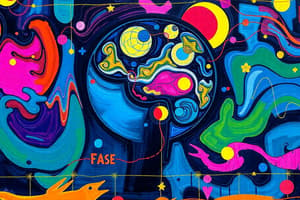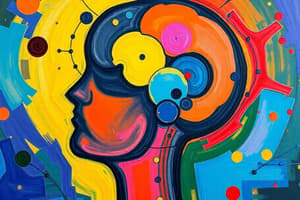Podcast
Questions and Answers
What is the primary role of the Reticular Activating System (RAS) in relation to consciousness?
What is the primary role of the Reticular Activating System (RAS) in relation to consciousness?
- It solely regulates sensory perception pathways.
- It is responsible for initiating REM sleep cycles.
- It controls hormonal responses to external stimuli.
- It plays a crucial role in regulating wakefulness and overall consciousness. (correct)
Which neurotransmitter is most closely associated with noradrenergic neuron activity in the locus coeruleus during wakefulness?
Which neurotransmitter is most closely associated with noradrenergic neuron activity in the locus coeruleus during wakefulness?
- Acetylcholine
- Dopamine
- Serotonin
- Norepinephrine (correct)
In which state of consciousness does the activity of noradrenergic neurons in the locus coeruleus peak?
In which state of consciousness does the activity of noradrenergic neurons in the locus coeruleus peak?
- During wakefulness (correct)
- During REM sleep
- During deep non-REM sleep
- During drowsiness
How do sensory stimuli influence the levels of consciousness?
How do sensory stimuli influence the levels of consciousness?
Which of the following brain regions is NOT involved in regulating wakefulness according to the provided information?
Which of the following brain regions is NOT involved in regulating wakefulness according to the provided information?
What are the two pathways of the Ascending Reticular Activating System (ARAS)?
What are the two pathways of the Ascending Reticular Activating System (ARAS)?
What role does the suprachiasmatic nucleus (SCN) play in circadian rhythms?
What role does the suprachiasmatic nucleus (SCN) play in circadian rhythms?
How does light affect melatonin secretion according to the information presented?
How does light affect melatonin secretion according to the information presented?
What can result from damage to the RAS or ARAS?
What can result from damage to the RAS or ARAS?
What does EEG stand for and what is its primary purpose?
What does EEG stand for and what is its primary purpose?
Flashcards
Consciousness
Consciousness
Awareness of internal and external stimuli, including perceptions, feelings, and thoughts.
Reticular Activating System (RAS)
Reticular Activating System (RAS)
Network in the upper brainstem crucial for regulating wakefulness, sleep, and consciousness.
Multimodal neurons
Multimodal neurons
Neurons responding to various stimuli, unlike unimodal ones.
Wakefulness Regulation
Wakefulness Regulation
Signup and view all the flashcards
Sensory influence on consciousness
Sensory influence on consciousness
Signup and view all the flashcards
Ascending Reticular Activating System (ARAS)
Ascending Reticular Activating System (ARAS)
Signup and view all the flashcards
Dorsal Pathway
Dorsal Pathway
Signup and view all the flashcards
Ventral Pathway
Ventral Pathway
Signup and view all the flashcards
Circadian Rhythms
Circadian Rhythms
Signup and view all the flashcards
Suprachiasmatic Nucleus (SCN)
Suprachiasmatic Nucleus (SCN)
Signup and view all the flashcards
Study Notes
Consciousness, Wakefulness, and Sleep
- Consciousness is awareness of internal and external stimuli (perceptions, feelings, thoughts).
- Specific neuron populations in the brainstem, hypothalamus, and basal forebrain regulate consciousness.
- These neurons project to the cerebral cortex to determine the consciousness state.
- Consciousness levels fluctuate throughout the day, from alertness to drowsiness.
- Sensory perception and consciousness are regulated by interacting neural pathways.
- Sensory stimuli influence consciousness levels. Excessive stimuli cause wakefulness; lack of stimuli leads to drowsiness/sleep. Conversely, consciousness levels affect sensory cortex sensitivity. Wakefulness increases sensitivity, while sleep/coma decreases it.
Reticular Activating System (RAS) and Wakefulness
- The RAS, located in the upper brainstem, is a network of nuclei regulating wakefulness, sleep & consciousness.
- RAS receives projections from somatosensory, visual, and auditory pathways.
- RAS neurons are multimodal, responding to diverse stimuli (unlike unimodal sensory neurons).
- RAS is a non-specific neural pathway.
- RAS includes nuclei like locus coeruleus (LC), pedunculopontine (PPT), laterodorsal tegmental (LDT) nuclei, raphe nuclei, substantia nigra (SNc), and ventral tegmental area (VTA), each with specific neurotransmitters (e.g., noradrenaline in LC).
- Activity of these nuclei varies across consciousness states (e.g., noradrenaline peaks in wakefulness).
- Increased RAS activity correlates with wakefulness.
- Other brain regions involved in wakefulness regulation include the hypothalamus (TMN, LHA) and basal forebrain, which are more active during wakefulness.
- The Ascending Reticular Activating System (ARAS) promotes wakefulness by projecting from the RAS, hypothalamus, and basal forebrain to the cerebral cortex.
- ARAS has two pathways: dorsal (through thalamic nuclei) and ventral (direct to cortex).
- Damage to the RAS/ARAS causes loss of consciousness (coma).
- General anesthetics and CNS depressants inhibit RAS/ARAS activity.
- CNS stimulants enhance RAS/ARAS activity.
Circadian Rhythms
- Circadian rhythms are natural 24-hour fluctuations in physical, mental, and behavioral processes.
- These rhythms influence sleep-wake cycles, activity, melatonin, body temperature, hormone secretion, blood pressure, and heart rate.
- Light is a key factor affecting circadian rhythms.
- The suprachiasmatic nucleus (SCN) in the hypothalamus is the biological clock.
- Retinal ganglion cells containing melanopsin (sensitive to blue light) transmit light information to the SCN via the retinohypothalamic pathway.
- The SCN regulates melatonin secretion from the pineal gland.
- Light input inhibits melatonin secretion, increasing levels in darkness.
- Melatonin typically rises between 9 PM and 10 PM, peaking during sleep.
- Melatonin receptors are throughout the brain and body, influencing circadian rhythms like sleep-wake.
Electroencephalography (EEG) and Sleep Stages
- EEG records brain electrical activity using scalp electrodes.
- EEG is used to diagnose neurological disorders, especially epilepsy.
- The EEG signal represents the sum of postsynaptic potentials (EPSPs and IPSPs) from pyramidal neurons in the cerebral cortex.
- Synchronized activity of pyramidal neurons produces EEG patterns.
Studying That Suits You
Use AI to generate personalized quizzes and flashcards to suit your learning preferences.




